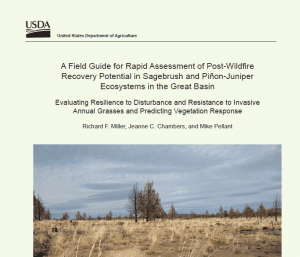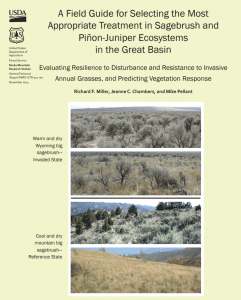Resistance & Resilience
View article.
This study evaluated nutrient availability and herbaceous recovery following various cutting and prescribed fire treatments in late succession western juniper woodlands on two sites in southeast Oregon from 2007 to 2012. Treatments were untreated controls, partial cutting followed by fall broadcast burning (SEP), cut and leave (CUT), and cut and burn in winter (JAN) and spring (APR). Soil inorganic N (NO3−, NH4+), phosphorus (H2PO4−), potassium (K+), and cover of herbaceous species were measured in three zones; interspace, litter mats around the tree canopy (canopy), and beneath felled trees (debris). Peak nutrient availability tended to occur within the first two years after treatment. The increases in N, P, and K were greatest in severely burned debris and canopy zones of the SEP and APR treatments. Invasive annual grass cover was positively correlated to soil inorganic N concentrations. Herbaceous composition at the cool, wet big sagebrush-Idaho fescue site was generally resistant to annual grasses after juniper treatments and native plants dominating post-treatment even in highly impacted debris and canopy zones of the SEP treatment. The warm dry big sagebrush-bluebunch wheatgrass site was less resistance and resilient, thus, exotic annual grasses were a major component of the understory especially when tree and slash burning was of high fire severity.
View paper.
This study found while understory perennial herbaceous plant cover remained low 1 and 2 yr post treatment, it increased by > 700% in all fuel-reduction treatment plots six growing seasons post treatment. Furthermore, while we observed minor increases in invasive annual grass, Bromus tectorum L. (cheatgrass), colonization in 2010 and 2011, there were substantial increases in B. tectorum cover by 2015. B. tectorum cover varied among treatments with the greatest cover in the unseeded mastication plot at nearly 30%. Seeding applications did not increase overall seed mix species cover but enhanced seed mix species richness and, thus, may have increased resistance to B. tectorum invasion in seeded treatment plots.
View article.
Results show that loss of perennial herbaceous species, which can result from inappropriate livestock grazing, and loss of shrubs, which often results from fire, interact to affect key functional groups. The implications are that ecosystem resilience to disturbance in Cold Desert shrublands decreases when competition from perennial native grasses and forbs for available resources no longer prevents dominance by A. tridentata and other shrubs and/ or annual invasive grasses. Managing livestock grazing to maintain or increase perennial herbaceous species, especially deep-rooted grasses, which contribute to resilience along elevation gradients, can help prevent threshold crossings to undesirable states and retain critical ecosystem services following disturbances such as wildfire.
View article.
In this paper, optimization models successfully identified areas with low conifer canopy cover, high resilience and resistance to wildfire and annual grass invasion, and high bird abundance to enhance sage-grouse habitat. The inclusion of mesic resources resulted in further prioritization of areas that were closer to such resources, but also identified potential pathways that connected breeding habitats to the late brood-rearing habitats associated with mesic areas. Areas identified by optimization models were largely consistent with and overlapped ongoing conifer removal efforts in the Warner Mountains of south-central Oregon. Land ownership of preferential areas selected by models varied with priority goals and followed general ownership patterns of the region, with public lands managed by the Bureau of Land Management and private lands being selected the most. The increased availability of landscape-level datasets and assessment tools in sagebrush ecosystems can reduce the time and cost of both planning and implementation of habitat projects involving conifer removal. Most importantly, incorporating these new datasets and tools can supplement expert-based knowledge to maximize benefits to sagebrush and sage-grouse conservation.
View article.
Collectively, the data analyzed in this study demonstrate that good condition ungrazed Wyoming big sagebrush plant communities exhibited resilience following fire and maintained a native-dominated mosaic of shrubs, bunchgrasses, and forbs. Further, unburned control plots were dominated by woody vegetation and exhibited losses in herbaceous understory, possibly indicating that they are outside of their natural fire return interval.
View article.
In this study, researchers determined vegetation response to fuel reduction by tree mastication (shredding) or seeding and then shredding by measuring cover of shrub and herbaceous functional groups on shredded and adjacent untreated areas on 44 sites in Utah. Findings suggested that shredding or seeding and then shredding should facilitate wildfire suppression, increase resistance to weed dominance, and lead toward greater resilience to disturbance by increasing perennial herbaceous cover.
View handbook.
This handbook discusses concepts surrounding landscape and restoration ecology of sagebrush ecosystems and greater sage-grouse that habitat managers and restoration practitioners need to know to make informed decisions regarding where and how to restore specific areas, by providing:
- Descriptions of plant dynamics of sagebrush steppe ecosystems and their responses to major disturbances, fire, and defoliation.
- Introductions of the concepts of ecosystem resilience to disturbances and resistance to invasions of annual grasses within sagebrush steppe.
- Introductions to soils and ecological site information will provide insights into the specific plants that can be restored in a location.
- Descriptions of concepts of landscape ecology that aid decisions regarding habitat restoration.
- Overviews of restoration techniques for sage-grouse habitat restoration.
- Descriptions of the critical nature of monitoring for adaptive management of sagebrush steppe restoration at landscape- and project-specific levels.
View article.
This study tested the stress-gradient hypothesis (SGH) in observations of 75 sites along overlapping water and heat stress and disturbance gradients. As stress-disturbance levels increase, sagebrush-herbaceous plant facilitation levels increase, the landscape will become increasingly aggregated as a product of necessary facilitation between sagebrush and herbaceous plants. This aggregation decreases the individual resilience of the native herbaceous plants, increases the competition from invasive plants, and decreases the overall stability and resilience of the sagebrush steppe ecosystem.
View field guide.
This field guide provides a framework for rapidly evaluating post-fire resilience to disturbance, or recovery potential, and resistance to invasive annual grasses, and for determining the need and suitability of the burned area for seeding. The framework identifies six primary components that largely determine resilience to disturbance, resistance to invasive grasses, and potential successional pathways following wildfire, as well as the information sources and tools needed to evaluate each component.
The components are: (1) characteristics of the ecological site; (2) vegetation composition and structure prior to the wildfire; (3) fire severity; (4) post-wildfire weather; (5) post-wildfire management, especially grazing; and (6) monitoring and adaptive management.
The tools provided are: (1) a conceptual model of the key components that largely determine resilience to disturbance and resistance to invasive annual grasses of the burn area, (2) a guide to evaluate post-wildfire severity, (3) indicators to estimate pre-wildfire plant composition and structure if not known, and (4) an evaluation score sheet to rate an area’s potential post-wildfire resilience to disturbance, resistance to invasive annual grasses and, thus, the need for seeding and probability of success.
View field guide.
This field guide identifies seven primary components that largely determine resilience to disturbance, as well as resistance to invasive grasses and plant succession following treatment of areas of concern. An evaluation score sheet is included for rating resilience to disturbance and resistance to invasive annual grasses and the probability of seeding success.




